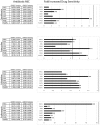Phage selection restores antibiotic sensitivity in MDR Pseudomonas aeruginosa
- PMID: 27225966
- PMCID: PMC4880932
- DOI: 10.1038/srep26717
Phage selection restores antibiotic sensitivity in MDR Pseudomonas aeruginosa
Abstract
Increasing prevalence and severity of multi-drug-resistant (MDR) bacterial infections has necessitated novel antibacterial strategies. Ideally, new approaches would target bacterial pathogens while exerting selection for reduced pathogenesis when these bacteria inevitably evolve resistance to therapeutic intervention. As an example of such a management strategy, we isolated a lytic bacteriophage, OMKO1, (family Myoviridae) of Pseudomonas aeruginosa that utilizes the outer membrane porin M (OprM) of the multidrug efflux systems MexAB and MexXY as a receptor-binding site. Results show that phage selection produces an evolutionary trade-off in MDR P. aeruginosa, whereby the evolution of bacterial resistance to phage attack changes the efflux pump mechanism, causing increased sensitivity to drugs from several antibiotic classes. Although modern phage therapy is still in its infancy, we conclude that phages, such as OMKO1, represent a new approach to phage therapy where bacteriophages exert selection for MDR bacteria to become increasingly sensitive to traditional antibiotics. This approach, using phages as targeted antibacterials, could extend the lifetime of our current antibiotics and potentially reduce the incidence of antibiotic resistant infections.
Figures


Similar articles
-
Expression of efflux pump MexAB-OprM and OprD of Pseudomonas aeruginosa strains isolated from clinical samples using qRT-PCR.Arch Iran Med. 2015 Feb;18(2):102-8. Arch Iran Med. 2015. PMID: 25644798
-
Contribution of mexAB-oprM and mexXY (-oprA) efflux operons in antibiotic resistance of clinical Pseudomonas aeruginosa isolates in Tabriz, Iran.Infect Genet Evol. 2016 Nov;45:75-82. doi: 10.1016/j.meegid.2016.08.022. Epub 2016 Aug 22. Infect Genet Evol. 2016. PMID: 27562333
-
MexAB-OprM- and MexXY-overproducing mutants are very prevalent among clinical strains of Pseudomonas aeruginosa with reduced susceptibility to ticarcillin.Antimicrob Agents Chemother. 2007 Apr;51(4):1582-3. doi: 10.1128/AAC.01334-06. Epub 2007 Jan 12. Antimicrob Agents Chemother. 2007. PMID: 17220417 Free PMC article. No abstract available.
-
Role of Efflux Pumps on Antimicrobial Resistance in Pseudomonas aeruginosa.Int J Mol Sci. 2022 Dec 13;23(24):15779. doi: 10.3390/ijms232415779. Int J Mol Sci. 2022. PMID: 36555423 Free PMC article. Review.
-
Efflux as a mechanism of resistance to antimicrobials in Pseudomonas aeruginosa and related bacteria: unanswered questions.Genet Mol Res. 2003 Mar 31;2(1):48-62. Genet Mol Res. 2003. PMID: 12917802 Review.
Cited by
-
Bacteriophage-Antibiotic Combinations for Enterococcus faecium with Varying Bacteriophage and Daptomycin Susceptibilities.Antimicrob Agents Chemother. 2020 Aug 20;64(9):e00993-20. doi: 10.1128/AAC.00993-20. Print 2020 Aug 20. Antimicrob Agents Chemother. 2020. PMID: 32571816 Free PMC article.
-
Drugs, Drugs, Drugs: Current Treatment Paradigms in Cystic Fibrosis Airway Infections.J Pediatric Infect Dis Soc. 2022 Sep 7;11(Supplement_2):S32-S39. doi: 10.1093/jpids/piac061. J Pediatric Infect Dis Soc. 2022. PMID: 36069901 Free PMC article. Review.
-
Resistance against two lytic phage variants attenuates virulence and antibiotic resistance in Pseudomonas aeruginosa.Front Cell Infect Microbiol. 2024 Jan 17;13:1280265. doi: 10.3389/fcimb.2023.1280265. eCollection 2023. Front Cell Infect Microbiol. 2024. PMID: 38298921 Free PMC article.
-
Leaky resistance and the conditions for the existence of lytic bacteriophage.PLoS Biol. 2018 Aug 16;16(8):e2005971. doi: 10.1371/journal.pbio.2005971. eCollection 2018 Aug. PLoS Biol. 2018. PMID: 30114198 Free PMC article.
-
Global trends and hotspots of phage therapy for bacterial infection: A bibliometric visualized analysis from 2001 to 2021.Front Microbiol. 2023 Jan 9;13:1067803. doi: 10.3389/fmicb.2022.1067803. eCollection 2022. Front Microbiol. 2023. PMID: 36699585 Free PMC article.
References
-
- De Kraker M. E. A., Wolkewitz M., Davey P. G. & Grundmann H. Clinical impact of antimicrobial resistance in European hospitals: excess mortality and length of hospital stay related to methicillin-resistant Staphylococcus aureus bloodstream infections. Antimicrob. Agents Chemother. 55, 1598–1605, doi: 10.1128/AAC.01157-10 (2011). - DOI - PMC - PubMed
-
- Cosgrove S. E. The relationship between antimicrobial resistance and patient outcomes: mortality, length of hospital stay, and health care costs. Clin. Infect. Dis. 42 Suppl 2, S82–S89 (2006). - PubMed
-
- Falagas M. E. & Karageorgopoulos D. E. Pandrug resistance (PDR), extensive drug resistance (XDR), and multidrug resistance (MDR) among Gram-negative bacilli: need for international harmonization in terminology. Clin. Infect. Dis. 46, 1121–1122; author reply 1122, doi: 10.1086/528867 (2008). - DOI - PubMed
Publication types
MeSH terms
Substances
LinkOut - more resources
Full Text Sources
Other Literature Sources
Research Materials

